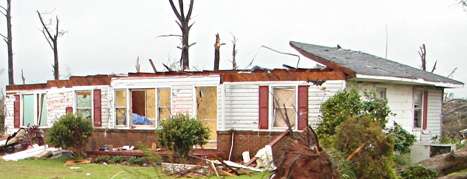Massive tornado onslaught raises questions about building practices, code enforcement

There is no practical, economic way to build structures that could stand up to the savagery of EF5 tornadoes like those that ripped through the South in late April, experts say, but damage from lesser storms could be reduced by better building practices and better enforcement of existing codes.
Researchers with a rapid assessment team supported by the National Science Foundation say that much of the damage could be linked to inadequate connections between building members, especially trusses, roof rafters and walls. And even though modern codes are generally adequate, they said, such codes are not always followed or enforced.
The result last month, one day of which has been called the fifth deadliest day of tornadoes in the nation's history, was 305 tornadoes, three of which were the maximum "EF5" category, that killed at least 326 people and may have caused more than $5 billion in damage.
"We often found inadequate or no connections at critical locations in structures, such as attaching the trusses or rafters to the supporting walls, or sill plate to the foundation," said Rakesh Gupta. He is a professor of wood science and engineering in the College of Forestry at Oregon State University, an expert in wind loading and structural resistance, and was a member of the NSF research team.
"Time and again we've seen that such connections are often inadequate under extreme loading conditions," Gupta said. "For instance, trusses that were just toe-nailed to the walls often failed in the high winds, the roof blew off and that allowed the rest of the building to collapse. And in some cases there were no anchor bolts between the bottom plate and foundation, allowing the whole building to shift off the foundation."
The final report from the assessment team is not yet complete, but early observations pointed not just to building codes, but enforcement of those codes, Gupta said.
"In one town in Alabama, I was told there is no inspection of homes by the city building inspector," he said. "Property taxes are very low, inspection is often inadequate, and sometimes that can result in inadequate construction quality and enforcement."
In many cases with the largest tornadoes, the researchers concluded, no existing codes or even quality construction practices made a difference.
"In an EF5 tornado, we observed that even new buildings built with the latest codes were totally destroyed," Gupta said. "One complex had used hurricane clips on trusses, the code-required nailing of roof and wall sheathing, and anchor bolts every four feet. It was destroyed right down to the concrete slab."
Gupta said that it would be possible to build structures that might resist an EF5 tornado, but not economically feasible.
"We could design a wood-frame house which would resist such forces, but who will pay for it?" he said.
Another part of the issue, researchers said, is that the more routine steps which can be taken to prevent greater storm damage are often easy and fairly inexpensive when a structure is being built, but comparatively expensive and difficult to do in retrofitting existing structures.
"When homes are under construction, the reality is that people are more interested in what they are spending on deluxe kitchen countertops and hardwood floors than some foundation bolt they never see," Gupta said. "The things it takes to improve structures and make them more safe are usually hidden behind the walls."
The team also observed that "safe rooms" designed with special construction features to provide refuge during severe storms may only work if a structure is of adequate size. On small houses or other buildings, the entire structure may be blown away and there is no safe place.
The research team will later compile its findings in a full report. Team members were from OSU, the University of Florida, University of Alabama, South Dakota State University, and some private industry agencies.
Provided by Oregon State University
















